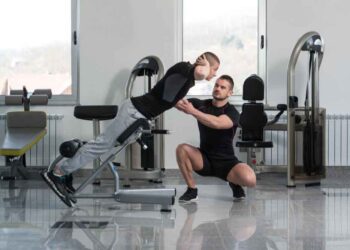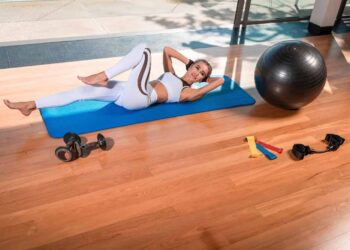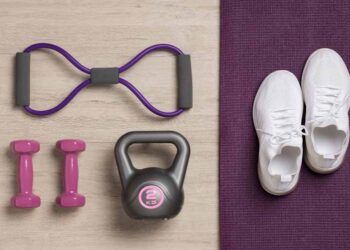Did you know that power walking can help you burn more calories and improve cardiovascular health just like running? In fact, power walking at a brisk pace can be just as effective as jogging, making it a fantastic option for those looking to boost their fitness and achieve their health goals.
Key Takeaways:
- Power walking is an effective way to increase your walking pace and maximize your workout benefits.
- By using specific techniques such as good posture, proper arm movement, and efficient foot motion, you can walk faster and more efficiently.
- Power walking offers numerous benefits, including improved cardiovascular health, increased calorie burn, and reduced risk of injury.
- Choosing the right shoes, focusing on your form and stride, and gradually increasing your pace can help you make the most out of your power walking routine.
- Power walking and running have their differences, so choose the activity that aligns with your fitness goals and fits your physical abilities and preferences.
Why Should You Power Walk?
Incorporating power walking into your fitness routine can bring about numerous benefits for your overall health and well-being. Whether you are aiming to shed those extra pounds or improve your cardiovascular endurance, power walking can be an effective and enjoyable exercise option.
Burn More Calories and Accelerate Weight Loss
One of the primary advantages of power walking is its ability to help you burn more calories and facilitate weight loss. By increasing your walking pace, you engage multiple muscle groups and intensify your workout. This elevated exertion results in a higher calorie expenditure, which contributes to a more efficient weight loss journey.
Additionally, power walking can be an excellent low-impact exercise option for individuals who want to lose weight without putting excessive strain on their joints. The consistent movement promotes fat burning and helps you achieve a healthy body composition.
Low-Impact Exercise for Joint Health
Unlike high-impact activities such as running, power walking is a low-impact exercise that reduces the risk of joint injuries. The controlled movements of power walking exert less stress on your joints, making it a suitable option for individuals with joint pain or conditions like osteoarthritis.
Improved Cardiovascular Health
Engaging in power walking regularly can significantly improve your cardiovascular health. When you power walk, your heart rate increases to a moderate or vigorous intensity, which enhances your overall cardiovascular fitness. This, in turn, reduces the risk of chronic diseases such as high blood pressure and type 2 diabetes.
Power walking is an effective way to enhance your heart health, as it promotes better blood circulation, strengthens your heart muscles, and helps maintain healthy blood pressure levels.
Mental and Emotional Well-being
Power walking not only benefits your physical health but also contributes to your mental and emotional well-being. Regular exercise releases endorphins, also known as “feel-good” hormones, which can improve your mood, reduce stress, and boost your overall mental outlook.
“Power walking is an efficient exercise option for individuals of all ages and fitness levels. Its low-impact nature, combined with its numerous health benefits, makes it an excellent choice for improving your overall well-being.”
Power Walking Workout Plan and Shoes
Creating a structured power walking workout plan can help you maximize the benefits and ensure progression over time. Consider including a warm-up and cool-down period in each session, gradually increasing your pace, and implementing interval training for added intensity.
Choosing the right pair of power walking shoes is crucial to support your feet and maintain proper alignment. Look for shoes that provide flexibility, lightweight design, and adequate cushioning to minimize the risk of foot and ankle discomfort during your power walking sessions.
The Table Shows a Comparison between Power Walking and Running:
| Activity | Power Walking | Running |
|---|---|---|
| Impact on Joints | Low impact, reduces strain on joints | High impact, more strain on joints |
| Calorie Burn | Varies based on pace and intensity | Higher calorie burn |
| Cardiovascular Health | Improves cardiovascular fitness | Improves cardiovascular fitness |
| Accessibility | Suitable for individuals with joint issues | Requires more joint strength and stability |
| Mental Well-being | Positive impact on mood and stress reduction | Positive impact on mood and stress reduction |
Incorporate Power Walking Into Your Routine
With its numerous benefits and flexibility, power walking can be a valuable addition to your fitness routine. Whether you prefer walking outdoors or using a treadmill, power walking can help you achieve your health and wellness goals.
Remember to start at a comfortable pace and gradually increase your intensity and duration. Listen to your body and consult with a healthcare professional if you have any concerns or medical conditions.
So lace up your shoes, embrace the power walk, and invigorate your exercise routine with a low-impact, calorie-burning workout that will boost your overall well-being!
How to Power Walk Correctly
Power walking is an effective way to boost your walking speed and maximize your workout. To power walk correctly, it’s important to focus on your form and stride. Follow these tips to enhance your power walking technique and get the most out of your workouts.
Select the Right Shoes
Choosing the right power walking shoes is crucial for optimal performance and comfort. Look for shoes that provide flexibility, lightweight construction, and adequate cushioning. These features will help support your feet and reduce the risk of injuries during your power walking sessions.

Maintain Proper Posture
Good posture is essential for effective power walking. Keep your body tall, with your chin up and shoulders relaxed. Engage your core muscles to stabilize your body, allowing for efficient movements and preventing excessive strain.
Swing Your Arms
Proper arm movement is key to power walking. Swing your arms naturally forward and backward while keeping your elbows bent at a 90-degree angle. The movement of your arms helps maintain balance and propels your body forward, enabling a faster pace.
Focus on Foot Motion
Pay attention to your foot motion while power walking. Land on your heel with each step and roll through to your toes. This motion promotes a fluid stride and ensures that your weight transfers smoothly, maximizing your power with every step. Avoid over-striding and take smaller, quicker steps to maintain a brisk pace.
Keep Up the Pace
Power walking is meant to be a vigorous activity, so maintain the speed and intensity throughout your session. Challenge yourself to increase your pace gradually as you become more comfortable with the technique. Remember to breathe deeply and maintain a steady rhythm.
By following these power walking tips for beginners and focusing on your form, you’ll optimize the benefits of your workouts and improve your overall fitness level. Incorporate power walking into your routine, and get ready to feel stronger, fitter, and more energized.
Power Walking vs. Running: Which is Better?
When it comes to cardio workouts, power walking and running are two popular options. Both activities provide excellent cardiovascular benefits, but they also have some key differences to consider. Let’s explore the advantages of each to help you decide which one is best for you.
Power Walking: A Low-Impact Option
Power walking is a low-impact exercise that puts less strain on your joints compared to running. This makes it an ideal choice for beginners or individuals with existing joint issues. By maintaining a brisk walking pace, you can still achieve an effective cardiovascular workout without the pounding impact that comes with running. Power walking allows you to improve your fitness and burn calories while minimizing the risk of injury.
Running: Intense and High-Impact
Running is a higher-impact exercise that offers a more intense cardiovascular workout. It requires a greater level of exertion, which can lead to increased calorie burn and improved aerobic capacity. Running can provide a sense of challenge and accomplishment, making it a great choice for individuals seeking a more vigorous workout. However, it’s important to note that running puts more stress on your joints, so it may not be suitable for everyone.
Choosing the Best Activity for You
When deciding between power walking and running, consider your fitness goals, preferences, and any physical limitations you may have. If you’re new to exercise or have joint issues, power walking may be the better option as it offers a low-impact alternative that still delivers cardiovascular benefits. On the other hand, if you enjoy high-intensity workouts and have no joint concerns, running may be a more suitable choice. The most important thing is to choose an activity that you enjoy and can stick with in the long term.
Ultimately, whether you choose power walking or running, both activities can significantly improve your cardiovascular health and overall fitness level. It’s essential to find an exercise routine that you enjoy and that aligns with your individual needs and preferences. So, lace up your shoes, hit the pavement, and start moving toward a healthier and more active lifestyle!
Power Walking Workout Plans
When it comes to power walking, having a structured workout plan can help you progress and reach your fitness goals. By gradually increasing your pace over time and incorporating interval training, you can enhance the effectiveness of your power walking workouts. In addition to focusing on your pace, it’s crucial to maintain proper posture throughout your workouts to maximize the benefits and prevent strain on your muscles and joints.
Gradual Pace Increase
To begin your power walking journey, start with a warm-up walk at a comfortable pace to prepare your body for the workout ahead. Once warmed up, gradually transition into a faster walking pace. Aim to maintain this increased pace for the duration of your workout. Over time, as your fitness level improves, challenge yourself by setting small milestones to increase your pace even further.
Interval Training
Interval training is an excellent way to add variety and intensity to your power walking workouts. It involves alternating between periods of faster walking and slower recovery walking. For example, you could power walk at a brisk pace for 2 minutes, followed by a 1-minute recovery walk at a slower pace. Repeat this pattern throughout your workout to elevate your heart rate, boost calorie burn, and improve cardiovascular fitness.
Listening to Your Body
While it’s essential to challenge yourself, it’s equally important to listen to your body and avoid overexertion or injury. If you feel any pain or discomfort during your power walking workouts, take a break and allow your body to recover. Be sure to schedule rest days in your workout plan to give your muscles and joints adequate time to rest and repair. Rest is just as crucial as exercise in achieving optimal results and preventing burnout.
Maintaining Good Posture
Proper posture is key to getting the most out of your power walking workouts. Stand tall with your shoulders relaxed and engage your core muscles. Keep your chin up, eyes forward, and avoid slumping or leaning forward. Imagine a straight line from your head to your feet, and make sure to maintain this alignment throughout your power walking sessions. Good posture will not only maximize the overall effectiveness of your workout but also prevent unnecessary strain on your muscles and joints.

Beyond the intensity of your power walking workouts, maintaining good posture is crucial for long-term success and injury prevention. By aligning your body properly, you utilize your muscles more efficiently and reduce the risk of overuse injuries. Good posture also enables you to breathe more deeply, optimizing oxygen intake and enhancing your overall performance.
To improve your posture during power walking, focus on the alignment of your head, neck, shoulders, and spine. Imagine a string pulling your head upward, elongating your spine and lifting your chest. Keep your shoulders relaxed and avoid slouching or rounding them forward. Engage your core muscles to support your back and maintain a stable and aligned posture throughout your entire power walking workout.
Remember, power walking is a low-impact exercise that can be enjoyed by people of all fitness levels. By incorporating these workout plans and maintaining proper posture, you can enhance the effectiveness of your power walking routines and achieve your fitness goals.
| Power Walking Workout Plans | Description |
|---|---|
| Gradual Pace Increase | Start with a warm-up walk and gradually increase your pace over time. |
| Interval Training | Alternate between periods of faster walking and slower recovery walking to increase intensity. |
| Listening to Your Body | Pay attention to your body’s signals and take rest days when needed to avoid overexertion. |
| Maintaining Good Posture | Ensure proper alignment of your head, neck, shoulders, and spine throughout your power walking workouts. |
Conclusion
Power walking is a fantastic exercise that can help you improve your fitness, burn calories, and enhance your overall health. By implementing proper techniques such as maintaining good posture, efficient arm movement, and correct foot motion, you can power up your walk and achieve faster and stronger results. Starting gradually and listening to your body is crucial to avoid injury and ensure long-term success.
Choosing the right power walking shoes is essential for comfort and support, as they can help prevent blisters, provide proper cushioning, and improve stability. Investing in a pair that fits well and suits your walking style will greatly enhance your experience and reduce the risk of discomfort.
Whether you’re a beginner or an experienced walker, power walking can be a great addition to your fitness routine. It offers a low-impact option for those looking to lose weight and improve cardiovascular health without the high-intensity impact of running. So lace up your power walking shoes, hit the pavement, and start power walking your way to a healthier you.
FAQ
What are the benefits of power walking?
How do I power walk correctly?
How does power walking compare to running?
Can power walking help with weight loss?
What should I include in my power walking workout plan?
Source Links
https://www.healthline.com/health/exercise-fitness/power-walking














